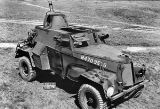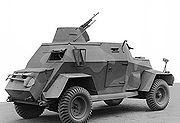
Humber Light Reconnaissance Car
Encyclopedia
The Humber Light Reconnaissance Car, also known as Humberette or Ironside, was a British
armoured car produced during the Second World War.
Produced by the Rootes Group, the Humber Light Reconnaissance Car was an armoured car based on the 4x4 Humber Heavy Utility (Humber box) chassis , effectively a derivative of the Humber Super Snipe
. It was equipped with a No. 19 radio set
. From 1940 to 1943 over 3600 units were built.
The vehicle was used by Infantry Reconnaissance Regiments and the RAF Regiment
in Tunisia
, Italy
and Western Europe
. After the war, some vehicles remained in service with the British units in India
and in the Far East
. The LRC was used widely by the Reconnaissance Corps
and was also used by the Reconnaissance squadron of the 1st Czechoslovak Independent Armoured Brigade Group.
Three Mk I vehicles were modified for use by the British Royal Family
and the Cabinet ministers
and were known as Special Ironside Saloons.

The original version with open-topped hull and 4x2 drive. Armament was a Boys anti-tank rifle and a Bren light machine gun. Only a limited number were built before the Mk I was replaced by the Mk II.
The Mk II had an enclosed roof with a turret for the machine gun and retained the 4x2 drive of the Mk I. The Boys faced forward in the front of the hull.

The Mk III was externally similar to the Mk II but had 4x4 drive. Production began in late 1941.
The only difference from the Mk III was additional vision ports at the front angles of the hull.
A reproduction also exists in private ownership in the Czech Republic
United Kingdom
The United Kingdom of Great Britain and Northern IrelandIn the United Kingdom and Dependencies, other languages have been officially recognised as legitimate autochthonous languages under the European Charter for Regional or Minority Languages...
armoured car produced during the Second World War.
Produced by the Rootes Group, the Humber Light Reconnaissance Car was an armoured car based on the 4x4 Humber Heavy Utility (Humber box) chassis , effectively a derivative of the Humber Super Snipe
Humber Super Snipe
The Humber Super Snipe was a car produced by the British-based Humber car company, part of the Rootes Group, from 1938 to 1967.-Pre-war Super Snipe:...
. It was equipped with a No. 19 radio set
Wireless Set No. 19
The Wireless Set No. 19 was a Second World War mobile radio transceiver designed for the British Army to give armoured troops reliable communications.- Specifications :...
. From 1940 to 1943 over 3600 units were built.
The vehicle was used by Infantry Reconnaissance Regiments and the RAF Regiment
RAF Regiment
The Royal Air Force Regiment is a specialist airfield defence corps founded by Royal Warrant in 1942. After a 32 week trainee gunner course, its members are trained and equipped to prevent a successful enemy attack in the first instance; minimise the damage caused by a successful attack; and...
in Tunisia
Tunisia Campaign
The Tunisia Campaign was a series of battles that took place in Tunisia during the North African Campaign of the Second World War, between Axis and Allied forces. The Allies consisted of British Imperial Forces, including Polish and Greek contingents, with American and French corps...
, Italy
Italian Campaign (World War II)
The Italian Campaign of World War II was the name of Allied operations in and around Italy, from 1943 to the end of the war in Europe. Joint Allied Forces Headquarters AFHQ was operationally responsible for all Allied land forces in the Mediterranean theatre, and it planned and commanded the...
and Western Europe
Western Front (World War II)
The Western Front of the European Theatre of World War II encompassed, Denmark, Norway, Luxembourg, Belgium, the Netherlands, France, and West Germany. The Western Front was marked by two phases of large-scale ground combat operations...
. After the war, some vehicles remained in service with the British units in India
India
India , officially the Republic of India , is a country in South Asia. It is the seventh-largest country by geographical area, the second-most populous country with over 1.2 billion people, and the most populous democracy in the world...
and in the Far East
Far East
The Far East is an English term mostly describing East Asia and Southeast Asia, with South Asia sometimes also included for economic and cultural reasons.The term came into use in European geopolitical discourse in the 19th century,...
. The LRC was used widely by the Reconnaissance Corps
Reconnaissance Corps
The Reconnaissance Corps or simply Recce Corps was a short-lived elite corps of the British Army whose units provided the mobile spearhead of infantry divisions from the Far East to Europe during the Second World War. It was formed from Infantry Brigade Reconnaissance Groups on 14 January 1941...
and was also used by the Reconnaissance squadron of the 1st Czechoslovak Independent Armoured Brigade Group.
Three Mk I vehicles were modified for use by the British Royal Family
British Royal Family
The British Royal Family is the group of close relatives of the monarch of the United Kingdom. The term is also commonly applied to the same group of people as the relations of the monarch in her or his role as sovereign of any of the other Commonwealth realms, thus sometimes at variance with...
and the Cabinet ministers
Cabinet (government)
A Cabinet is a body of high ranking government officials, typically representing the executive branch. It can also sometimes be referred to as the Council of Ministers, an Executive Council, or an Executive Committee.- Overview :...
and were known as Special Ironside Saloons.
Variants

- Mk I
The original version with open-topped hull and 4x2 drive. Armament was a Boys anti-tank rifle and a Bren light machine gun. Only a limited number were built before the Mk I was replaced by the Mk II.
- Mk II
The Mk II had an enclosed roof with a turret for the machine gun and retained the 4x2 drive of the Mk I. The Boys faced forward in the front of the hull.

- Mk III (1941)
The Mk III was externally similar to the Mk II but had 4x4 drive. Production began in late 1941.
- Mk IIIA (1943)
The only difference from the Mk III was additional vision ports at the front angles of the hull.
Surviving vehicles
A number of vehicles are preserved in museums:- Dutch Cavalry MuseumDutch Cavalry MuseumThe Dutch Cavalry Museum is located in the centre of The Netherlands in the city of Amersfoort. The museum is hosted in two large buildings at the Bernhardkazerne army barracks....
- Royal Museum of the Armed Forces and of Military HistoryRoyal Museum of the Armed Forces and of Military HistoryThe Royal Museum of the Armed Forces and Military History The Royal Museum of the Armed Forces and Military History The Royal Museum of the Armed Forces and Military History (or simply the Royal Military Museum (RRM) is a museum that occupies the two northernmost halls of the historic complex in...
, Brussels, Belgium - Royal Air Force Museum London has a Mk IIIA
- National War and Resistance Museum, Overloon has a wheeless LRC hull
- Military College of EME, Trimulgherry has an LRC as a gate guardian
- 43rd Reconnaissance Regiment Living History Group (UK) operate an LRC MK I
A reproduction also exists in private ownership in the Czech Republic

